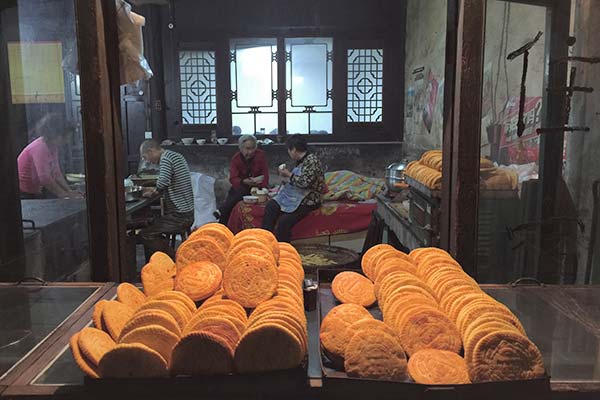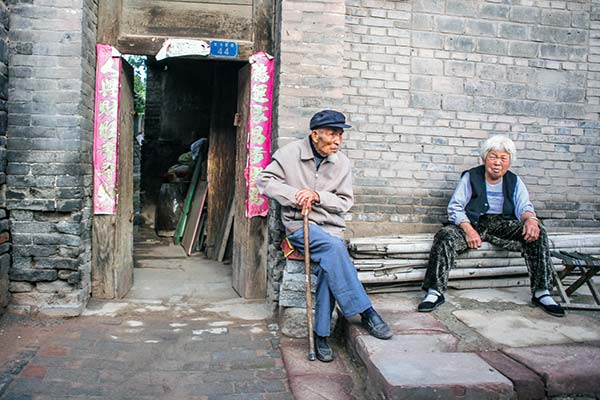
The old government office, an iconic building in Pingyao, Shanxi province, presents the Chinese aesthetics and the officialdom culture. [Zhang Wei / China Daily]
The ancient city of Pingyao in Shanxi province is one of the best places to savor China’s past and see well-preserved old city walls and traditional Chinese architecture.
It feels exciting to stroll on the streets lined with houses built of grey bricks and tiles that have survived wars and natural disasters.
It is not as commercial as other ancient Chinese cities and you can see history everywhere. The ancient city lets you immerse yourself in its history.
Its iconic yamen-a government office in feudal China-is one of the few well-preserved yamen left. It’s a place where the county magistrate lived and dealt with government affairs. The large complex showcases the culture of officialdom then and the county magistrate’s daily life.

A street stall sells local sweet cakes in Pingyao. [Wang Wenlan / China Daily]
Outside the gate of the yamen is the Declaration Pavilion. It’s a place where a venerable old man voted by the locals would mediate in civil disputes such as fights and land disputes. If the issue still remained unresolved, then the county magistrate would accept the case.
Zhu Yuanzhang, the first emperor of the Ming Dynasty (1368-1644), ordered regional governments to build such pavilions, to relieve county magistrates from trivialities so they could have more energy to deal with important matters.
Stepping beyond the gate, you will see a prison in the left yard, the only remaining prison from the Qing Dynasty (1644-1911) in China.
There are also exhibitions of official documents and various instruments used to torture and execute criminals in ancient China in other yards.
It is interesting to see recreations of ancient Chinese court trials in the court hall every day. Dressed in traditional costumes, performers take on the roles of prosecutors and defendants speaking in local dialects. Then when the performer playing the role of the county magistrate makes his decision, he throws a black token from the desk to the ground and announces his judgment. Red tokens are used for the death penalty.

Two elderly residents take a rest in front of their houses. [Kok Mun How / China Daily]
The last building of the yamen is the Fairy Fox Tower with a history of more than 600 years. The county magistrate would have simple meals, drink tea and treat his superiors there. He worshipped and enshrined the fairy fox on the second floor of the tower because it was believed that the fairy would guard the official seal and ensure that he had a successful career.
In the past, Pingyao’s young women would get a set of lacquer ware as dowry when they got married.
The best place to learn about this traditional handicraft is the Pingyao Lacquer Ware Arts Museum.
Common patterns painted on lacquer ware are animals and mythological and legendary characters. The cats painted on the lacquer ware are so vivid that you can even see their fine hair. It takes about half a year to finish a common cosmetic case.
There are also lacquer cabinets, tables and screens there.
As part of the production process, the unfinished item would be placed in the shade for a long time for it to dry after the lacquering was done on the elegant basswood. It would then go through painting and polishing.
When we visited, several female workers were using sandpaper to rub down a cupboard door with an elegant phoenix pattern on it.
After doing that for an hour, they use a lump of human hair to polish it for half an hour.
Then, they brush sesame oil on it and rub it with brick dust, and then with French chalk in the last step.
The more the article is polished, the brighter it gets. It is supposed to look like a mirror after all the polishing is done.
In the Ming (1368-1644) and Qing dynasties, Shanxi merchants were famous for their diligence in doing business in commodities such as tea and salt.
They even started the Rishengchang-China’s first piaohao in Pingyao. Piaohao means a draft bank that allows people to exchange drafts for cash at its branches in the country.
In its heyday, Pingyao had 22 piaohao, and China had 51 in total at that time.
Nowadays, the Rishengchang has become the Piaohao Museum and displays areas showing different functions such as a business hall, a VIP room, an account’s office and living quarters of the staff.
The Rishengchang had such a good system to prevent fraud that there were no cases of people falsely claiming money. Besides watermarks and seals on the draft, there were special Chinese characters representing dates, months and figures. There was also special staff handwriting on the drafts to avoid misappropriation.
You can also watch a performance called Another Glance at Pingyao every afternoon and night except on Mondays, to know more about the local culture and the loyalty of Pingyao’s people.
The show is staged close to the ancient city and tickets cost 198 yuan ($31). The show tells the story of Zhao Yishuo, a local piaohao owner who went all the way to Russia with armed staff to save a subordinate’s son.
The show is more like an unique time-travel experience to the late Qing Dynasty.
The theater has been renovated to look like the ancient town, with a bustling street of different stores and performers dressed in traditional costumes.
And rather than sitting on seats, members of the audience have to walk around and interact with the cast. They can also watch excellent dance shows.
